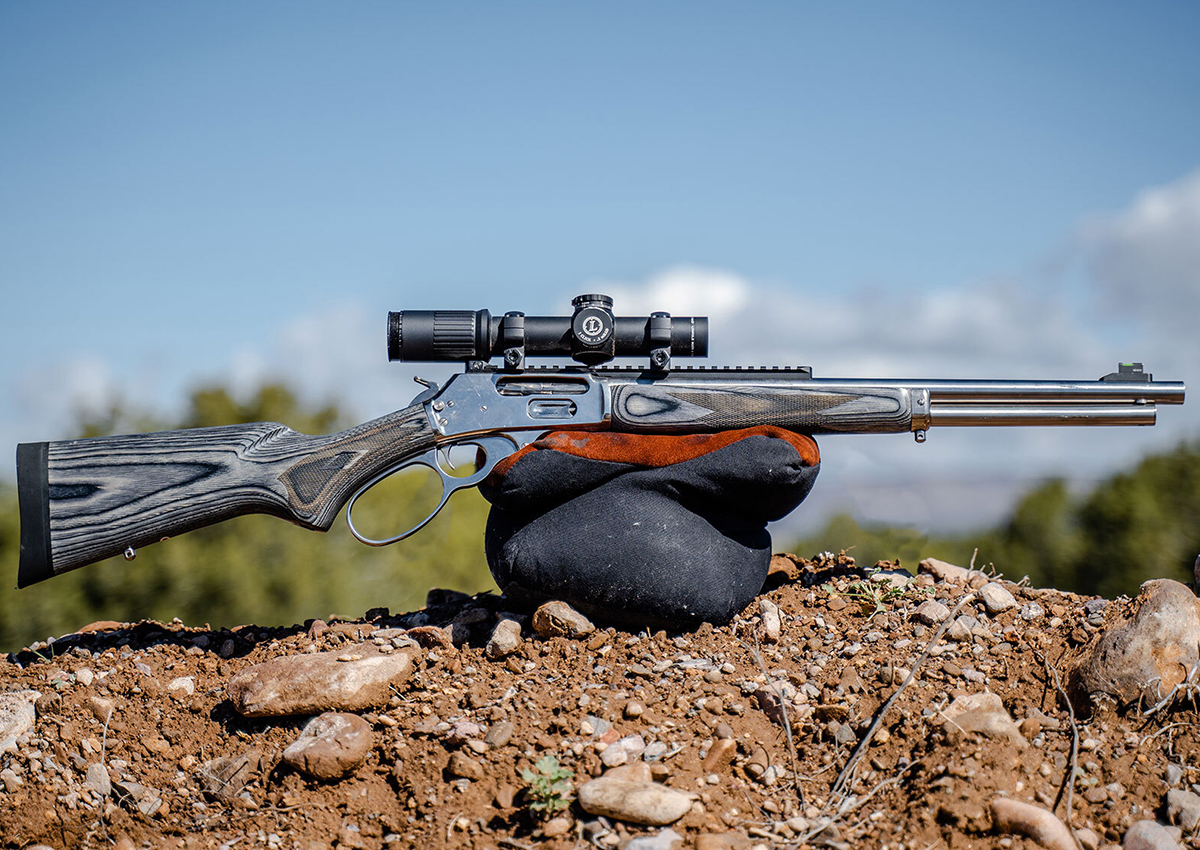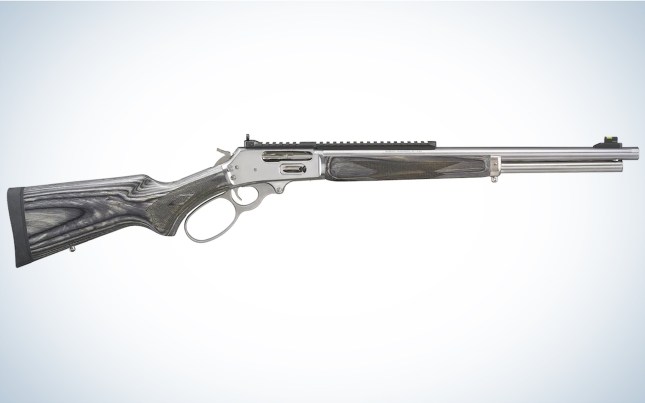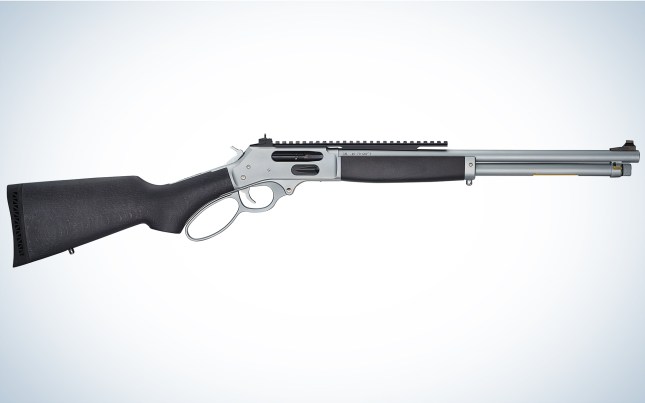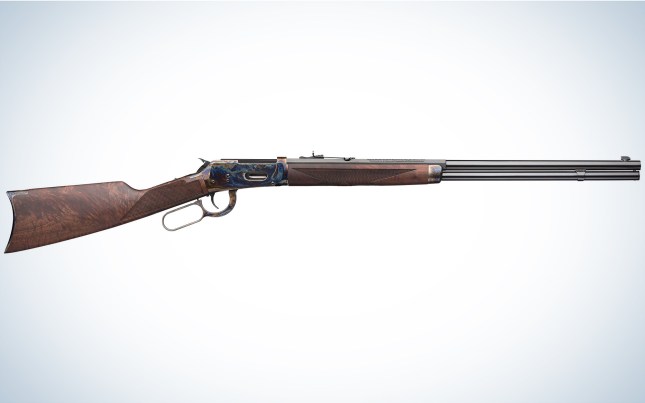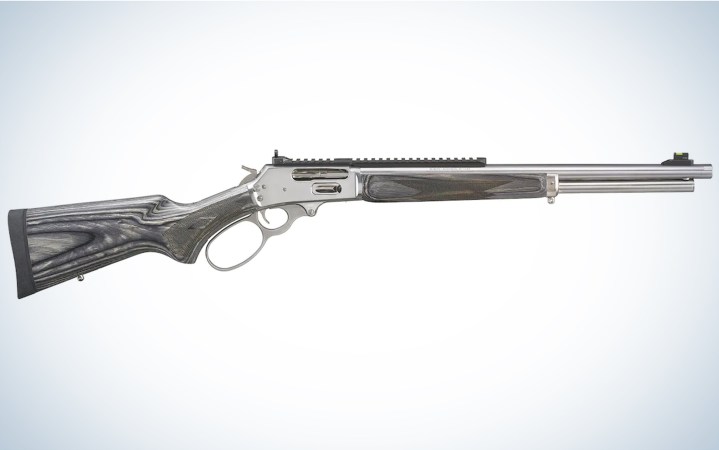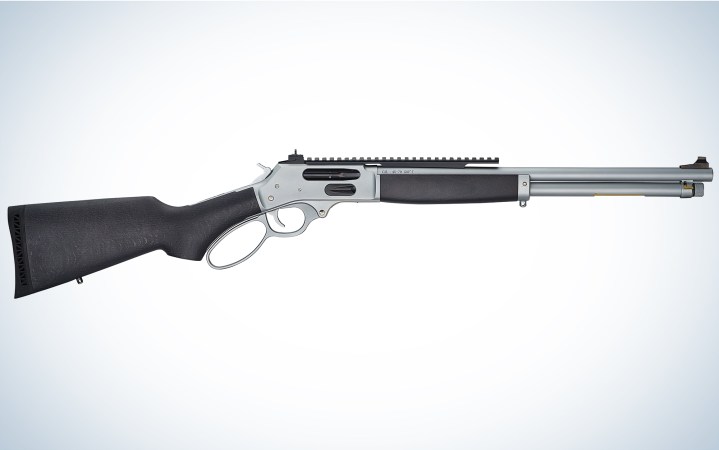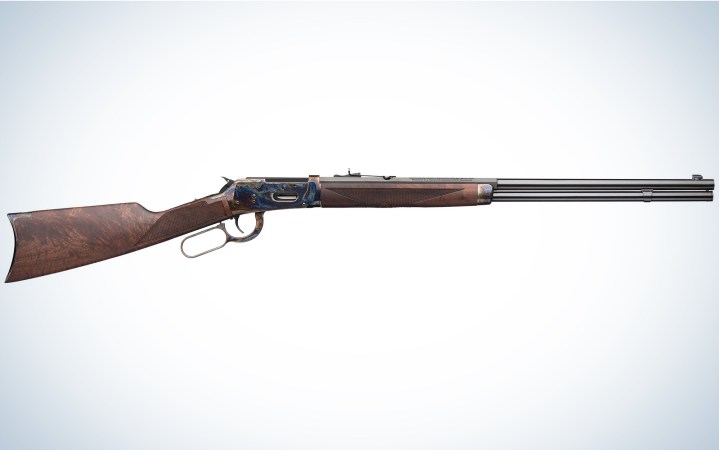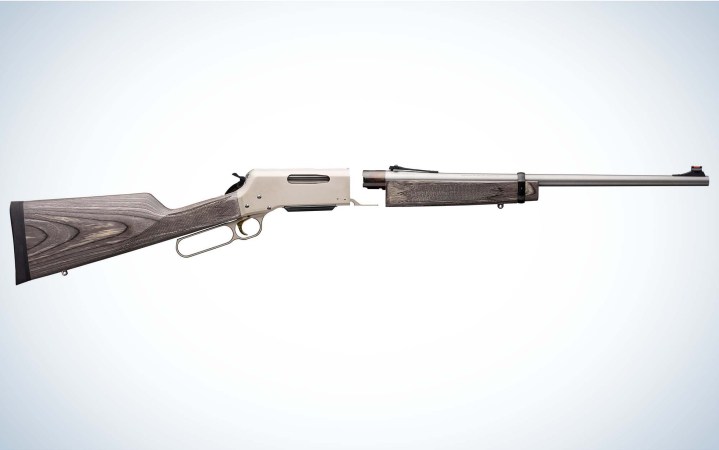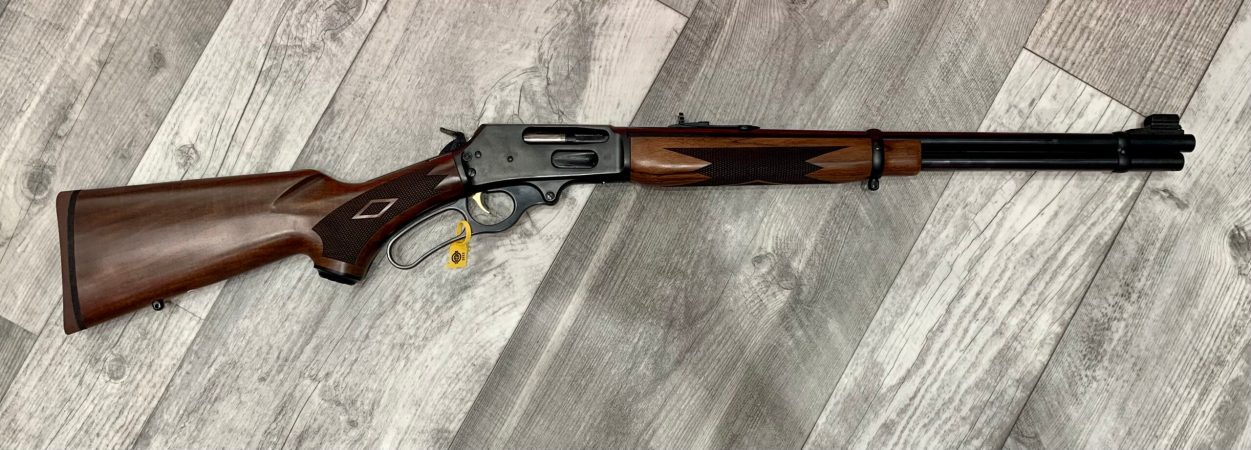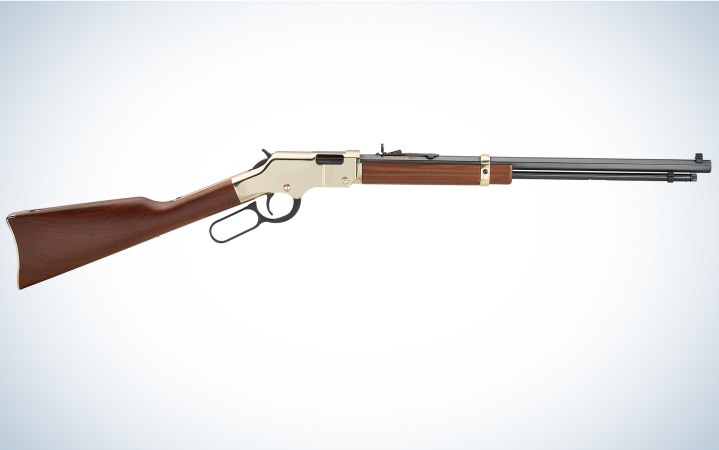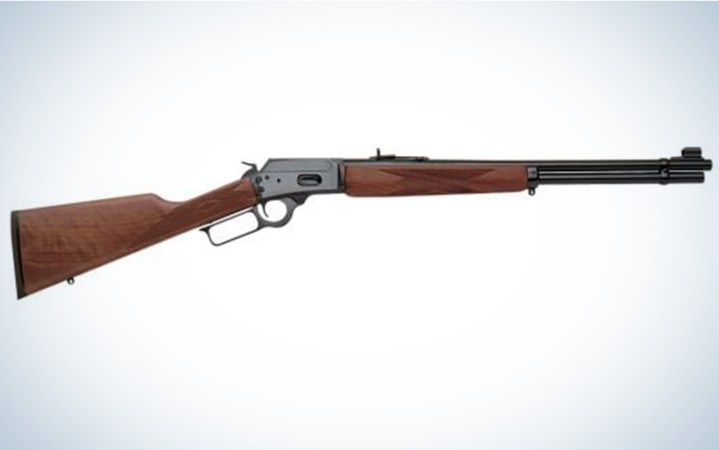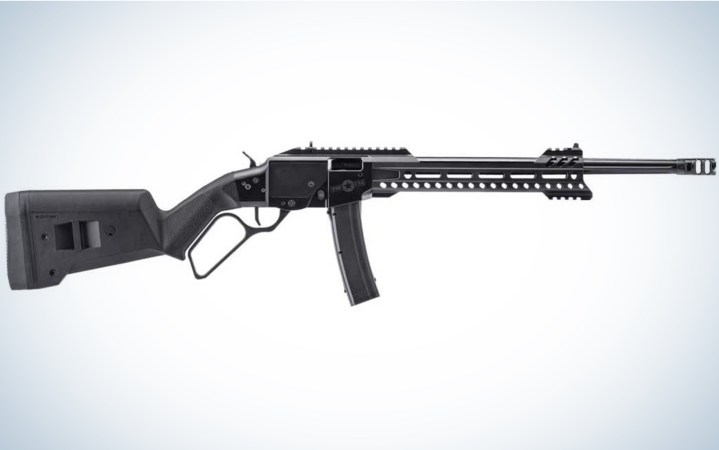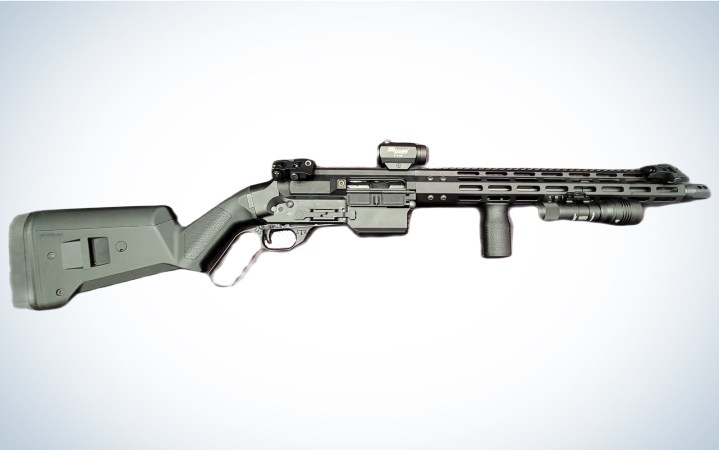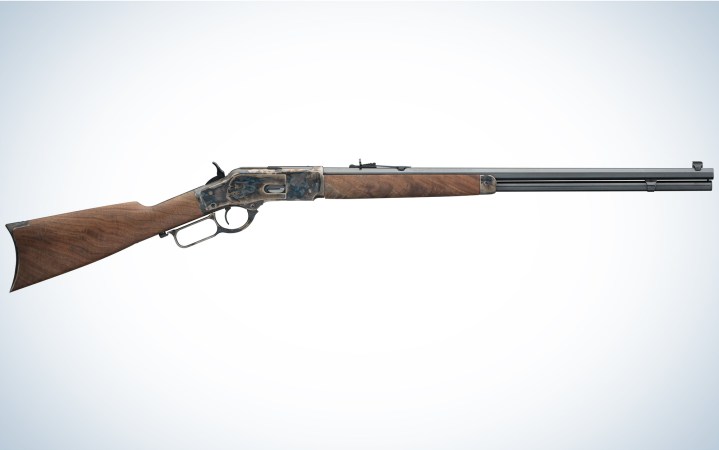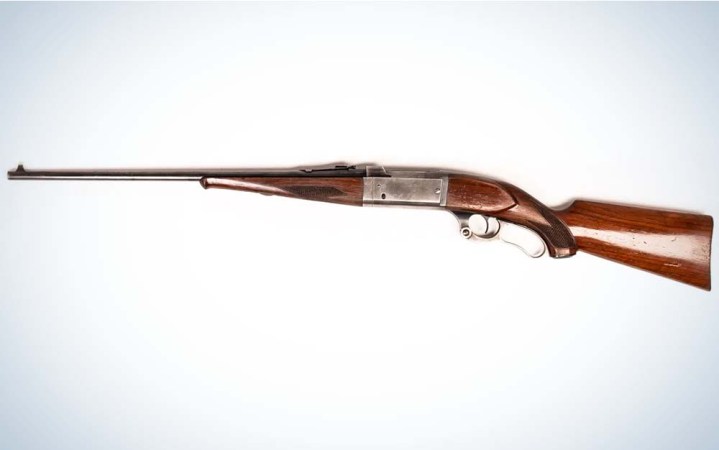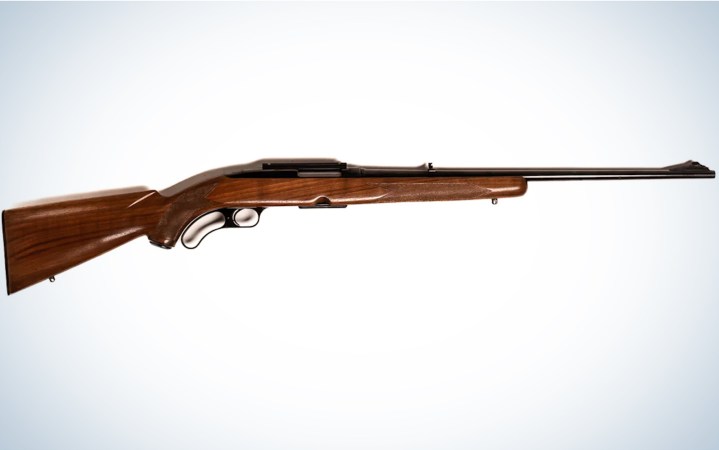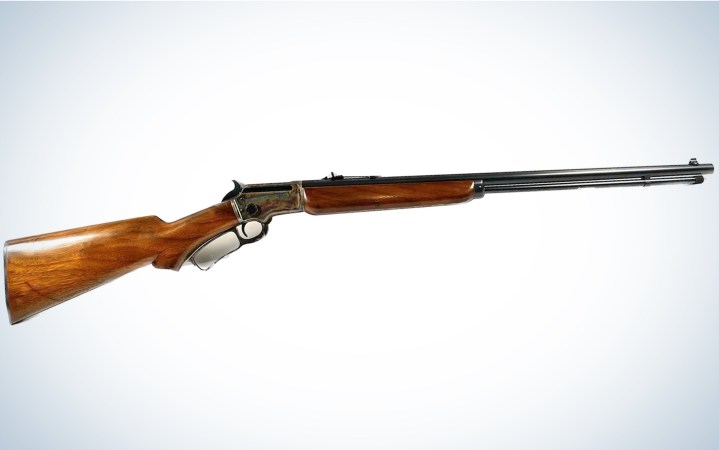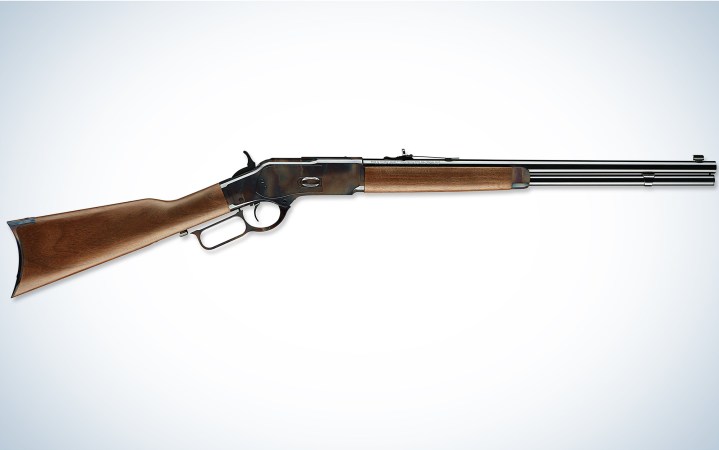We may earn revenue from the products available on this page and participate in affiliate programs. Learn More ›
When I was a kid, there were three reasons I wanted a lever action rifle. First, they were cool. Second, because I grew up just outside New Haven, Conn., the historic home to Marlin and Winchester, they were my hometown guns. Third, they were cheap.
Only one of these things is still true. Lever guns always have been and always will be cool, though they will never again be cheap, nor—barring divine intervention—will they ever again be produced in Gun Valley.
Writing about the top lever action rifles is a bit tricky. Do you focus on the best of all time, which is a great for us nostalgic sorts, or do you talk about great lever action rifles that you can buy new? (Though given some of the lingering shortages, it might be more accurate to say the lever guns you can put yourself on a waiting listing for.)
I tilted this list of the best lever action rifles in favor of those you can order new. Though if you have a hankering for one of the old-time classics, there are plenty to be had on the used market. Just don’t expect to find any bargains. Nearly all quality lever actions command a premium.
- Marlin 1895
- Henry All-Weather Picatinny Rail .45/70 Side Gate
- Winchester Model 94
- Browning BLR
- Marlin 336
- Henry Golden Boy
- Marlin 1894
- POF-USA Tombstone
- Bond Arms Lever Action
How I Picked the Best Lever Action Rifles
This list is divided into those guns that are being currently produced (or soon-to-be) in significant numbers and those that are either specialty orders or that must be sought out on the used gun market.
With the exception of the rifles that have just been announced, I’ve shot, handled, and/or owned all the models listed. Beyond my hands-on experience with the rifles over the years, however, many of them are no-brainers based on their well-documented history and legacy.
Best Lever Action Rifles Currently Made
The good—actually, great—news here is that we’re seeing more lever actions made with each passing year. A couple years back, Remington screwed the pooch with Marlin and those were some dark days indeed. In those years it seemed only Henry was making quality lever guns in meaningful numbers, but things have taken a turn for the better.
Under Ruger’s ownership, Marlin seems poised to flourish. Henry is still innovating hard and trotting out new models in new cartridges, like the 360 Buckhammer. And we have a couple interesting and innovative newcomers in the mix.
Marlin 1895
Key Features
- Caliber: .45/70 Govt
- Capacity: 6+1
- Stock: Gray Laminate
- Material: Stainless Steel
- Sights: High-Vis Tritium fiber optic with an adjustable ghost ring
- Weight: 7.3 lb.
- Length 37.25 in.
- Barrel: 19.1 in., cold-hammer forged, threaded 11/16-24
- Twist: 1:20
- Cost: $2,110
Pros
- The new Ruger-made Marlin 1895s are the finest factory-produced Marlins in history.
Cons
- Supply is still nowhere near in line with demand. Many are being resold for premiums on the used gun market.
When Ruger resurrected Marlin, the first model they brought back was the 1895 SBL. This was a smart move because the SBL, with its gray laminate furniture, stainless steel metal, threaded barrel, oversized lever loop, and picatinny rail was one of the sexiest and most sought-after iterations of this classic lever action.
I had good things to say about the Marlin 1895 SBL when it was reintroduced in late 2021, and that opinion hasn’t shifted. It is the best lever action rifle produced under the Marlin brand—at least in the modern era. Packing 6+1 rounds of .45/70 Gov’t in its magazine, it brings a formidable level of firepower to the party which is why it has garnered a lot of interest from hunters in bear country, as well as with everyday sportsmen in more sedate parts of the U.S.

Marlin has also introduced two new versions of the 1895 worth considering, a Model 1895 Trapper and a Model 1895 Guide Gun. The Trapper comes with a Skinner peep sight, no picatinny rail, and is a bit more compact (34 ¼ in. vs. 37 ¼ in.) than the SBL. It, too, is chambered in .45/70 and has a 5+1 magazine capacity. The Guide Gun (model GBL) is slightly less expensive than the SBL ($1,239 vs. $1,479), has traditional semi-buckhorn sights, blued steel, is chambered in .45/70, and a 6+1 capacity.
Henry All-Weather Picatinny Rail .45/70 Side Gate
Key Features
- Caliber: .45/70 Govt
- Capacity: 4+1
- Stock: Stained hardwood
- Material: Hard chrome with a stain finish
- Sights: Ghost ring on a Picatinny rail
- Weight: 7.1 lb.
- Length 37.5 in.
- Barrel: 18.43 in.
- Twist: 1:20
- Cost: $1,598
Pros
- Affordable, available and versatile.
Cons
- None worth noting.
It didn’t seem that long ago that Henry Repeating Arms was only making Golden Boys chambered in pistol cartridges and .22s. But these guys have been busy, and as the company embarks on its second quarter century, they have added an impressive number of products to the lineup.
One of the flagship hunting rifles is the All-Weather Picatinny Rail .45/70 Side Gate, which is Henry’s version of a do-everything guide gun. As the name implies, it is built for the elements. The metal has a hard-chrome satin finish. The stock is a stained hardwood.
It has an aperture peep sight mounted at the rear of the substantial Picatinny rail. Henry outfitted it with an oversized lever loop. With the 18.43-inch barrel, the overall length is 37.5 inches and it has a 4+1 capacity. The rifle can be loaded either through the side gate on the receiver or by dropping rounds into the tubular magazine.
This is a versatile and capable thumper that is equally at home in bear country or in a deer stand overlooking a food plot.
Winchester Model 94
Key Features
- Caliber: .30/30 Win.
- Capacity: 8+1
- Stock: Grade V/VI Walnut, 22 lpi checkering
- Receiver: Case color hardened
- Sights: Marble adjustable semi-buckhorn
- Weight: 7.5 lb.
- Length 42.5 in.
- Barrel: 24 in.
- Twist: 1:12
- Cost: $1,280
Pros
- Arguably the most iconic of deer rifles. A true classic.
Cons
- Expensive
The Winchester Model 1873 might have been The Gun that Won the West—a great bit of marketing by Winchester executives—but the Model 94 is undeniably the rifle that won the hearts and minds of generations of deer hunters. If you polled long-time hunters regarding their choice as the top lever action rifle, there’s little doubt the Winchester 94 would win the vote.
This was the most prolific of Winchester’s lever actions, being the first sporting rifle in the U.S. to sell a million units. Prior to the end of its domestic production in 2006, more than seven million Model 94s were produced.
Model 94s are still being made for Browning/Winchester by Miroku Corp. in Japan and are available in several different grades. These run from the basic Carbine ($1,309) with its plain walnut stock and brushed polished blued metal, to the Deluxe Sporting ($2,230), which has case color hardened metalwork, upgraded wood, nicely executed checkering, and a half-round, half-octagonal deeply blued barrel.
Currently, the 94 is being offered in .30/30 Win., .38/55 and .450 Marlin.
Browning BLR
Key Features
- Caliber: .30/06
- Capacity: 4
- Stock: Laminate, 18 lpi checkering
- Receiver: Aluminum alloy, matte nickel finish
- Sights: Marble adjustable with Tru-Glo fiber-optic front
- Weight: 7.25 lb.
- Length 43 in.
- Barrel: 22 in.
- Twist: 1:10
- Cost: $1,480
Pros
- All-purpose versatility. Handy takedown.
Cons
- In some shooters’ eyes has never attained “classic” status.
The Browning BLR is one of the most versatile lever actions on the market. It is available in both short- and long-action lengths and because it feeds from a detachable box magazine it is able to run pointy spitzer-style bullets in cartridges usually associated with bolt guns.
The Lightweight ’81 Stainless Takedown is the most utilitarian BLR of them all, making it the best lever action rifle in the BLR family. It breaks down into two pieces for easy transport and is built on a lightweight aluminum receiver and sports a stainless steel barrel for excellent weather resistance. At about 7.25 pounds (depending on the specific chambering) it has a very nice balance and feel. Combined with its smooth lever system, which uses a clever gear and pinion design, the BLR embodies the lithe, fast-handling characteristics that lever action fans admire. (I’d be remiss if I didn’t give a nod to the legendary Winchester Model 88, which was a game-changing lever action from which the BLR drew lots of inspiration.)
The Lightweight ’81 Takedown is currently chambered in .243 Win., 6.5 Creedmoor, 7mm-08 Rem., .308 Win., .300 WSM, .30/06, and .300 Win. Mag. Several other cartridges are available in other BLR models as well.
Marlin 336
Key Features
- Caliber: .30/30 Win.
- Capacity: 6+1
- Stock: Black walnut
- Receiver: Blued alloy steel, CNC machined from forgings
- Sights: Adjustable semi-buckhorn
- Weight: 7.5 lb.
- Length 38.6 in.
- Barrel: 20.25 in., cold hammer-forged
- Twist: 1:12
- Cost: $1,239
Pros
- Wonderful craftsmanship. Quintessential brush gun.
Cons
- Going to be scarce for a while.
It’s difficult for me to express how happy I am to include the Marlin 336 among the top lever action rifles currently made. I know I’m not alone in this. I cut my teeth hunting deer with a Marlin 336 in .35 Remington so, as with countless other hunters, the 336 was my first love.
We’ve handled and put a few rounds through one of the new 336’s, which will initially be chambered in .30/30 Win., and its quality was spot-on. As with the 1895s, the 336s have excellent fit and finish, run smoothly, and are aesthetically pleasing.
As for timing, expect to see the first Marlin 336’s shipping mid- to late-spring. The .35 Rem. is in the hopper, but those of us craving the return of that chambering will have to wait until later this year.
Also, don’t be surprised to see the 336 offered in Remington’s 360 Buckhammer in 2023 as well.
Henry Golden Boy
Key Features
- Caliber: .22 LR
- Capacity: 16+1
- Stock: Black walnut
- Receiver: Polished Brasslite
- Sights: Adjustable semi-buckhorn
- Weight: 6.75 lb.
- Length 38.5 in.
- Barrel: 20 in., octagon blued steel
- Twist: 1:16
- Cost: $636
Pros
- Slick, fun, handy. Consummate plinker.
Cons
- As long as it fits your budget, there is absolutely nothing wrong with this rifle.
As you history buffs probably know, the original Henry lever action was the first commercially successful lever action rifle. Originally chambered in .44 Rimfire, it was one of the most advanced firearms to see action during the Civil War and was fielded in limited numbers by Union Troops.
Confederate Colonel John Mosby is credited with cursing it as “that damned Yankee rifle that can be loaded on Sunday and fired all week,” after fighting against troops wielding it in battle. That unintentional endorsement stuck and helped propel the Henry to everlasting fame.
Henry makes a “New Original Henry” chambered in either .44-40 WCF or .45 Colt, though the most popular (and affordable) homage is the Henry Golden Boy rimfire, which can be had in .22 S/L/LR, .22 Mag., or .17 HMR.
In .22 LR, the most popular configuration, the rifle holds 16 rounds, the same as the original. It has a 20-inch octagonal barrel that is nicely blued and contracts sharply with the bright “Brasslite” finished receiver and brass buttpad and barrel band.
The receiver comes drilled and tapped for a scope, but before you mount an optic on yours spend some time running it with semi-buckhorn sights, as the Creator intended.
These Golden Boys run like a scalded squirrel and can digest ammo by the brick over the course of an afternoon.
As a first gun for a youngster, it has no real equal. But its appeal is so strong that no one will fault you for buying one for your grownup self first.
Marlin 1894
Key Features
- Caliber: .44 Mag./.44 Spl.
- Capacity: 10+1
- Stock: Black walnut
- Receiver: Blued alloy steel, CNC machined from forgings
- Sights: Adjustable semi-buckhorn
- Weight: 7.25 lb.
- Length 38.5 in.
- Barrel: 20.25 in., cold hammer-forged
- Twist: 1:20
- Cost: TBD
Pros
- Based on the samples I’ve seen, should be as well made as other Ruger Marlins.
Cons
- As with other Marlins, will be difficult to find.
The Marlin 1894 was hot stuff when it was introduced back in the day. It was the first lever gun with a flat top, side-eject design that anticipated the eventual wide-spread adoption of telescopic sights on rifles. This innovation gave it a leg up (on paper anyway) compared to the Winchester 1894 which debuted at the same time, though the fact that the Winchester came in the potent .30/30 versus the less powerful offerings in the Marlin gave Winchester’s 1894 a decisive advantage.
The Marlin 1894 has been chambered in a variety of mostly pistol-caliber cartridges over the decades, the most common of which (in the modern era) included the .44 Spl./.44 Magnum. .38 Spl./.357 Magnum and .45 Colt. I have a North Haven, Conn., built 1894 in .44 Magnum and it is one of my favorite carbines. (Though if I could snap my fingers and conjure any 1894 it would be one chambered in the quaint and now obsolete .218 Bee.)
Ruger announced the return of the Marlin 1894 this spring, so we will hopefully have hands-on range time with one soon for a full review. Expect to see the first offerings in the cartridges mentioned above, but as details become available we’ll update this information. (Note: the rifle pictured above is one of the older Marlin 1894s).
POF-USA Tombstone
Key Features
- Caliber: 9mm
- Capacity: 10- or 20-round magazine
- Stock: Magpull SGA
- Receiver: Aluminum
- Sights: XS ghost ring on a Picatinny rail
- Weight: 5.75 lb.
- Length 36 in.
- Barrel: 16.5 in., free floated, threaded ½-28
- Twist: 1:10
- Cost: $1,962
Pros
- Cool design. Opening the lever action market to a new type of shooter.
Cons
- A bit expensive compared to what can be purchased for a similar price. Also, if you need a muzzle brake on a 9mm carbine you should probably seek medical attention.
Guess what—the Tombstone doesn’t give a damn about your nostalgic attachment to the past. This new arrival has turned a lot of heads with its uber-modern take on the lever action rifle.
Chambered in 9mm, it feeds via detachable 10- or 20-round magazines—the same ones POF uses on their Phoenix pistol.
The 16.5-inch barrel is free-floated, threaded ½-28, and comes with a dual-port muzzle break that isn’t really necessary but compliments the Tombstone’s tactical vibe. (Truth is, it is just a placeholder for a suppressor, which elevates the Tombstone’s fun-factor by an order of magnitude.)
The fore-end has a couple Picatinny rail sections as well as numerous M-Lok slots, so there is no shortage of places to mount accessories. The receiver is topped with a Picatinny rail as well and includes an integrated XS Ghost Ring sight.
It runs Magpul’s SGA 870 buttstock, which includes two flush attachment points for a sling and a grip angle that is much steeper than is typical on a lever action. The Tombstone is about 36 inches long, and has an advertised weight of 5 ¾ pounds, which makes it handy and quick to wield.
The base black model is $1,962, while the FDE version runs $2,097. The Tombstone isn’t cheap, but there’s no shortage of shooters looking to throw down their money to get one.
Bond Arms Lever Action
Key Features
- Caliber: 9mm/5.56mm NATO/.300 BLK
- Capacity: Runs from AR-15 compatible mags
- Stock: Magpull SGA
- Lower material: Aluminum
- Sights: N/A
- Weight: TBD
- Length: TBD
- Barrel: TBD
- Cost: $1,500 (Est.)
Pros
- An innovative concept and cool way to leverage (pardon the pun) the AR-15 platform.
Cons
- We don’t know how well it will really work or what it will cost yet.
This interesting rifle isn’t available quite yet—the company hopes to launch it later in 2023—but I wanted to include it since it is an excellent example of the lever action’s enduring appeal.
The idea of this rifle is simple: An AR-15 compatible lever action lower that can run a standard upper. The execution of it is quite complex, however, and involves a lot of innovation, particularly in the linkage system to get the appropriate leverage and timing to cycle 30-round magazines.
The throw on the lever is short—for quick cycling—but features a variety of camming forces to extract rounds from the chamber and strip rounds packed tight in higher-capacity magazines. From just the mechanical standpoint, this is a fascinating design.
Bond expects to offer this rifle as a complete system for about $1,500, though final pricing is TBD as the company works to bring this concept to production. As with the POF Tombstone, the Bond Arms Lever Action uses the Magpul SGA 870 buttstock, meaning any Remington 870 compatible stock can be swapped in its place.
Another cool feature is the rifle’s user-configurable lever loop that allows the shooter to swap to a larger loop if desired. In fact, this rifle’s AR-15 mix-and-match modularity promises to spawn interesting configurations as shooters experiment with the platform.
Best Lever Action Rifles: The Classics
This list could have been much longer, but in the interest of brevity I’ve only highlighted a few notable classic lever guns. Before getting to those, however, I do want to highlight a couple important honorable mentions.
The Spencer repeating rifle is one. It was the first military repeating rifle that used self-contained metallic cartridges and is the forefather of all lever actions. Though the Spencer was produced for only a short time (1860 to 1869) and in relatively limited numbers, it was the steppingstone upon which the lever action rifle, specifically Winchesters, was built.
The Winchester 1895, which gained prominence as Teddy Roosevelt’s “Big Medicine” in .405 Winchester is an iconic lever action whose fame outstrips its actual benefits. From a technical standpoint, its most distinguishing element is that it was the first Winchester lever action fed from an internal box magazine.
Winchester 1886
Key Features
- Caliber: .45/70 Gov’t.
- Capacity: 8+1
- Stock: Grade III/IV Walnut
- Receiver: Steel color case hardened
- Sights: Semi-buckhorn
- Weight: 9.75 lb.
- Length 43 in.
- Barrel: 24 in., octagonal
- Twist: 1:20
- Cost: $1,930
Pros
- The first real lever action for big game cartridges.
Cons
- Hard to find and a bit spendy.
This was the first big-boy lever action in history. The Winchester 1886 changed the game because it’s strong locking-block action was able to handle proper rifle cartridges, rather than the pistol rounds that previous lever action designs were limited to.
It was originally chambered in .45/70 and .45/90, two rounds you can still get it in. Over the years it was loaded for other hard-hitting rounds like the .50/110 Winchester and .33 WCF.
Those rounds, combined with its excellent handling characteristics, made the Model 1886 the first true big-game capable lever action. Today, you can order it in a Saddle Ring Carbine configuration ($1,630) with a 22-inch barrel, in “Short Rifle” trim ($1,450) with a 24-inch round barrel, or go all out with the fancy Deluxe Case Hardened model ($1,930) with a 24-inch octagonal barrel, upgraded walnut and color case hardened receiver.
Savage Model 99
Key Features
- Weight: 6.6 pounds
- Capacity: 5 rounds (.308 Win.)
Pros
- One of the top candidates as the lever action GOAT. It is both timeless and ahead of its time.
Cons
- You’re going to pay through the nose for one in good condition.
Arguably the finest lever action ever (and if there’s one thing lever gun fans like to do its argue about which is best), the Savage Model 99 was a revolutionary addition to the American sporting scene when it was trotted out in 1899.
It had an elegant, hammerless design, used an innovative rotary magazine that allowed the rifle to safely chamber cartridges with spitzer-style pointed bullets, and a stock silhouette that oozed sexiness and speed decades before such aesthetics became the hallmark of art deco industrial design.
First called the Model 1899, it officially changed to the Model 99 in 1921 when the .300 Savage was introduced. Initially, the 1899 was chambered in .303 Savage and .30/30 Win. Soon, Savage added other cartridges to the lineup—the most iconic of which was Charles Newton’s speedster, the .250-3000 Savage, in 1915. Later in life, the Model 99 added the .243 Win., .308 Win., 7mm-08 Rem., .375 Win. and others to the mix.
My Model 99 is a particularly lovely rifle. It was given the me by my father-in-law before he passed away and is a takedown model chambered in .300 Savage that includes a .410 gauge barrel that it shoots single-shot.
The rifle was sold by Abercrombie and Fitch to legendary car maker Carroll Shelby, who eventually gave it to my father-in-law as a gift. It’s still in its original case of leather and wood lined with purple velvet. I rarely shoot it—but admire it frequently.
Winchester Model 88
Pros
- One of the most significant evolutionary designs in lever action history.
Cons
- Its looks and feel weren’t for everyone, but enough hunters took a shine to it to make it the third-best selling lever action in Winchester’s history.
Though it never gained the following of the Savage 99, the Winchester Model 88 is similar to the Savage in that it incorporated a lot of technical innovation in its design and caused hunters and shooters to reassess the lever action platform.
Winchester unveiled it in 1955. It had a short lever throw and used a rotating three-lug bolt that smoothly stripped rounds from the detachable box magazine. The Model 88 was chambered in a handful of cartridges that were new at the time, specifically the .308 Win., .243 Win., .284 Win. and the .358 Win., which was a particularly terrific brush round that is sadly all but forgotten these days.
The Model 88 has a hammerless design and side eject, which allows for easy mounting of an optic on the receiver. One particularly clever feature is how the trigger moves with the lever loop, eliminating the possibility of a pinched finger or snagged glove when working the action.
Marlin 39A
Pros
- The best rimfire lever action rifle ever.
Cons
- Ruger isn’t making them—yet. Used 39A’s command a premium.
I don’t think there’s a rimfire lever action as beloved as the Marlin 39A. It tops many shooters’ lists as the best .22 LR ever produced. The legacy of the 39A is fascinating. It started as the Model 1891 and was the first .22 LR lever action produced. Its legendary accuracy was demonstrated by Annie Oakley who used one in her shooting exhibitions. The Model 39A held the distinction of being the longest continually produced shoulder-fired firearm in history. That streak was broken when the dimwits who purchased Marlin and placed it under the Remington umbrella decided to move Marlin’s production facilities from North Haven, Conn., to Ilion, New York—at which point the production of all Marlins ground to a (predictable) halt.
My sincere hope is that we’ll soon—as in the next couple years—be able to reclassify the 39A under the “Best Lever Action Rifles Being Currently Made” category since it seems Ruger is doing such a fabulous job reviving Marlin since they purchased it.
Winchester 1873
Key Features
- Caliber: .44-40 WCF
- Capacity: 14+1
- Stock: Grade V/VI Walnut
- Receiver: Steel color case hardened
- Sights: Semi-buckhorn
- Weight: 8 lb.
- Length 43 in.
- Barrel: 24 in., half octagon/half round
- Twist: 1:36
- Cost: $2,190
Pros
- The gun that won the West. Nuff said.
Cons
- A genuine used one is going to cost dearly. Newer imports don’t have the same cachet.
When you think “cowboys” and the “Old West” the first rifle that comes to mind is this beauty. The Winchester 73 really was the right gun for the right time—being the first rifle chambered for the .44-40, which is said to be the first centerfire cartridge developed. Whether it deserved to be called “The Gun that Won the West” as Winchester touted, there’s no denying that the Model 73 was used to send a whole bunch of men—both good and bad—to their maker, and accounted for along innumerable head of deer and other game to boot.
The Model 1873 was produced until 1923 but has enjoyed a revival since the sport of cowboy action shooting sprang up. Uberti makes replicas chambered in .357 Mag. and .45 Colt, while Winchester, which worked with their Japanese partner Miroku, has been importing ’73s since 2013. Those are available in .357 Mag., .45 Colt, and .44-40 WCF.
FAQs
Since the barrel of a lever action is longer than that of a handgun, cartridges like the .357 Mag. and .44 Mag. get a significant performance boost in terms of velocity that makes them more capable on animals like deer and hogs.
In addition, a lever-action chambered in .357 can run .38 Spl. rounds, which are economical and have little recoil making it a great option for plinking and practice.
Yes. They are fast-handing, quick-shooting, easy to wield and carry, hold good quantities of ammo, are available in a wide range of cartridges for different applications, and are legal in most all jurisdictions. Whether you’re on horseback with one in a scabbard or have a take-down model in a bug-out bag, lever-actions are an excellent choice.
Absolutely. The Marlin 1895 SBL carried by Chris Pratt’s character—dinosaur whisperer Owen Grady—in Jurassic World, would be a top choice as a dino stopper, provided it was loaded with heavy, hard-hitting ammo like Buffalo Bore’s 380-grain mono-metal WFN dangerous-game load.
Certainly. A carbine-length lever action chambered in a pistol cartridge like .357 Mag. or .44 Mag. would be a highly effective option for home protection. Even a rifle chambered in .22 Win. Mag. can be a formidable home-defense gun when loaded with ammo like Federal Punch.
Final Thoughts on the Best Lever Action Rifles
Usually when one compiles a “best of” list—whether talking deer rifles, elk cartridges, or sniper rifles—there is significant push-back with the selections. Everyone has deeply-held convictions on such matters.
With lever action rifles, it is a bit different. There are many rifles that are universally agreed upon. No one in their right mind is going say that a Savage 99 isn’t one of the best lever action rifles of all time. The same goes for the Model 94, Marlin 336 and others.
I think we rally around lever actions because they are the quintessential American rifle. Yes, we make the best bolt-actions in the world, and the same can be argued with other firearms platforms—but the lever action is distinctly ours. Though some are made abroad and imported, the lever action is, and always will be, America’s rifle.
